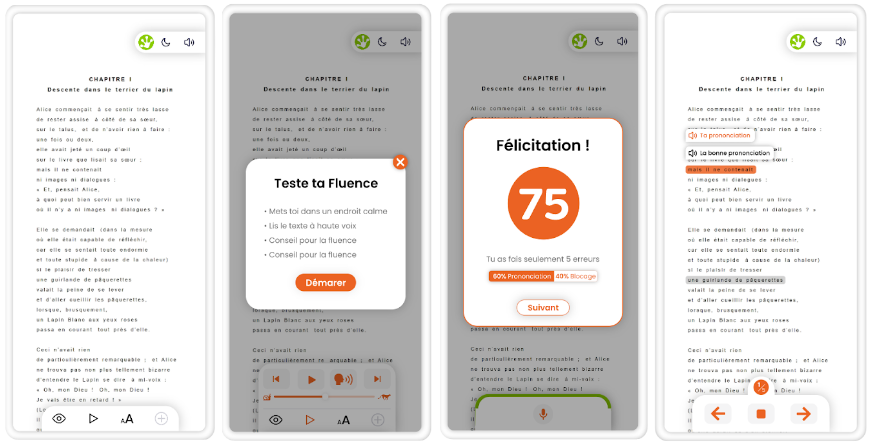Evaluating reading fluency : a new tool available in SONDO and SONDIDO
The most recent national oral fluency test in France demonstrated that nearly 50 percent of students entering middle school are insufficiently fluent. In the United States, the 2018 NAEP Oral Reading Fluency study showed that 36 percent of fourth-grade public school students performed below NAEP Basic. To respond to this issue, Mobidys teamed up with the computer lab LIA in Avignon, Speech and Language Laboratory at University of Aix-Marseille, and the Rabelais Center for Language & Integration to develop a new evaluation tool.“Supercalifragilisticexpialidocious! Even though the sound of it is something quite atrocious!” Were you able to read these sentences without stumbling, and understand their meaning? If so, bravo! You’ve mastered the art of fluency—and the language of Mary Poppins. If not, don’t panic. The ability to read a text correctly and naturally takes practice, especially so for dyslexic readers. To help them learn fluency, we have worked with several scientific and professional partners to develop a new fluency evaluation tool. Our goal is to help children practice reading aloud and evaluate their own reading fluency, in keeping with our wish to empower people to read.
What is reading fluency?
An indicator of reading comprehension
In France, teachers define reading fluency as the “capacity to correctly read a continuous text at conversation pace with appropriate prosody.” (Bianco, M. (2016).
Fluency combines three elements :
- precision (correct identification of words);
- speed (automaticity);
- and prosody (reading with appropriate expression, including tone, intonation, rhythm, pauses, and stresses). (Raskinski, T., 2004)
A child’s level of fluency is highly indicative of their degree of reading proficiency.
Advanced readers automatically identify words because they have developed the ability to quickly and efficiently recognize text features such as the relationship between phonemes and graphemes, spelling rules, sentence construction, and overall organization. This lets them concentrate their attention on comprehension and prosody. The ability to read fluently, therefore, reduces cognitive load, freeing up more attention to devote to higher-level reading activities, like textual comprehension, implicit meaning, inferences, etc.
On the other hand, struggling readers who cannot automatically decode words while reading will experience cognitive overload. This leaves few resources to focus on understanding the text and prosody. Because their attention is entirely concentrated on
identifying the words in front of them, reading feels particularly difficult and their reading is not fluent.
In the case of dyslexic readers, these difficulties are linked to specific cognitive disorders that can affect the grapheme-phoneme relationship (phonological dyslexia), memorization
and whole-word recognition (surface dyslexia), or the distinction between certain letters.
Insufficient reading fluency at the fourth-grade level
The ability to read and understand a variety of texts is part of the common core standards, and is an important evaluation criterion for children at the fourth grade level in France.
At the end of fourth grade, children should in theory be able to read a prepared text of about 1,500 characters at an age-appropriate lexical and syntactical level with satisfactory reading fluency. (“Reading: building a path to reading independence.” Bulletin official de l’éducation nationale, 5 April 2018.). This is evaluated using a timed reading of a passage to measure the number and accuracy of words read.
Data collected in recent years by the French Ministry of Education indicates that a large number of fourth-grade students display insufficient reading fluidity. During the last national fluency test conducted in 2021, nearly 50 percent of students presented reading difficulties. These difficulties are particularly pronounced in schools located in priority education zones and those with a large proportion of socially disadvantaged students.
In light of this information, the French government declared access to reading a national concern for the 2021–2022 school year. In a document addressed to the national education system, the minister presented a method for establishing a national action plan for primary grades through high school.
Evaluating reading fluidity :
A new FROG fluency screening tool available in SONDO and SONDIDO
It can be difficult to evaluate reading fluency in the classroom and at home. For teachers, this implies being able to plan for regular reading time with each student and to ensure special follow-up with those who need it. For many children, especially those with dyslexia, reading out loud in front of their teacher and classmates can be stressful.
Therefore, we wanted to develop a new support tool that would be useful to both students and teachers.
Integrated into the FROG toolbar, this new feature lets children self-record a text of their choice directly in the interface. The speech analysis tool scores their fluency level and highlights reading errors in the text. Students can play back their recording as well as listen to the correct pronunciation of the word or group of words they are struggling with. Then they can practice as many times as they like and track their progress.
Screenshots from the FROG reading fluency evaluation tool
Tools based on research and professional methods
- Corinne Fredouille, professor, Laboratoire Informatique d’Avignon (Avignon Computer Laboratory), who researches automatic speech recognition and prosodic error identification;
- Muriel Lalain, head of research at CNRS, Laboratoire Parole et Langage de l’Université d’Aix-Marseille (Speech and Language Laboratory at Université d’Aix-Marseille), whose work focuses on characterizing the types of possible oral reading errors made by people with language disorders;
- Le centre Rabelais Langage et Intégration (the Rabelais Center for Language and Integration), a therapy and learning center for children with severe language disorders, which provides us access to actual audio recordings of children with reading difficulties and allows us to test our solutions directly with them.
